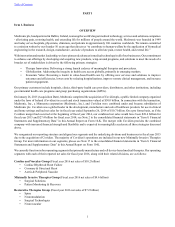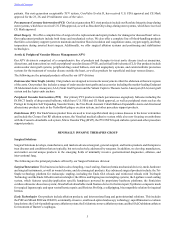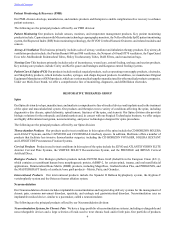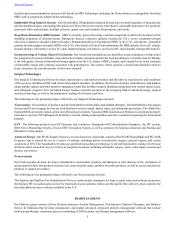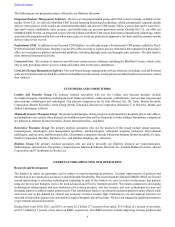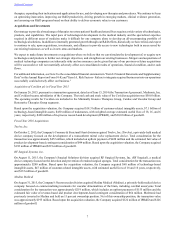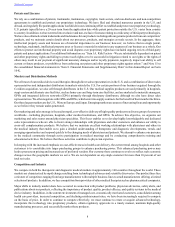Medtronic 2016 Annual Report Download - page 14
Download and view the complete annual report
Please find page 14 of the 2016 Medtronic annual report below. You can navigate through the pages in the report by either clicking on the pages listed below, or by using the keyword search tool below to find specific information within the annual report.
Table of Contents
11
existing regulations. Certain regulators are requiring local clinical data in addition to global clinical data. While harmonization of
global regulations has been pursued, requirements continue to differ significantly among countries. We expect this global regulatory
environment will continue to evolve, which could impact our ability to obtain future approvals for our products, or could increase
the cost and time to obtain such approvals in the future. There can be no assurance that any new medical devices we develop will
be approved in a timely or cost-effective manner or approved at all.
Ongoing U.S. FDA Regulations
Both before and after a product is commercially released, we have ongoing responsibilities under U.S. FDA regulations. The U.S.
FDA reviews design and manufacturing practices, labeling and record keeping, and manufacturers’ required reports of adverse
experiences and other information to identify potential problems with marketed medical devices. We are also subject to periodic
inspection by the U.S. FDA for compliance with the U.S. FDA’s quality system regulations, which govern the methods used in,
and the facilities and controls used for, the design, manufacture, packaging, and servicing of all finished medical devices intended
for human use. In addition, the U.S. FDA and other U.S. regulatory bodies (including the Federal Trade Commission, the Office
of the Inspector General of the Department of Health and Human Services, the U. S. Department of Justice, and various state
Attorneys General) monitor the manner in which we promote and advertise our products. Although surgeons are permitted to use
their medical judgment to employ medical devices for indications other than those cleared or approved by the U.S. FDA, the U.S.
FDA has prohibited manufacturers from promoting products for such “off-label” uses, and has taken the position that manufacturers
can only market their products for cleared or approved uses.
If the U.S. FDA were to conclude that we are not in compliance with applicable laws or regulations, or that any of our medical
devices are ineffective or pose an unreasonable health risk, the U.S. FDA could require us to notify health professionals and others
that the devices present unreasonable risks of substantial harm to the public health, order a recall, repair, replacement, or refund
of such devices, detain or seize adulterated or misbranded medical devices, or ban such medical devices. The U.S. FDA may also
impose operating restrictions, enjoin and/or restrain certain conduct resulting in violations of applicable law pertaining to medical
devices, including a hold on approving new devices until issues are resolved to its satisfaction, and assess civil or criminal penalties
against our officers, employees, or us. The U.S. FDA may also recommend prosecution to the U. S. Department of Justice. Conduct
giving rise to civil or criminal penalties may also form the basis for private civil litigation by third-party payers or other persons
allegedly harmed by our conduct.
In April 2015, we entered into a consent decree with the U.S. FDA relating to our Neuromodulation business’ SynchroMed drug
infusion system and the Neuromodulation quality system. The consent decree requires the Company to complete certain corrections
and enhancements to the SynchroMed pump and the Neuromodulation quality system. The consent decree limits the Company's
ability to manufacture and distribute the SynchroMed drug infusion system, unless specific conditions are met. The agreement
does not require the retrieval of any of the Company’s products, but the Company must retain a third-party expert to inspect the
Neuromodulation quality system and to provide a certification that the system complies with the requirements of the consent
decree. Once this certification is accepted by the U.S. FDA, and a U.S. FDA inspection is successfully completed, the limitations
on manufacturer and distribution of SynchroMed pumps will be lifted. Thereafter, the Company must submit periodic audit reports
to the U.S. FDA to ensure ongoing compliance with the consent decree.
In June 2016, TYRX, Inc. received a Warning Letter from the U.S. FDA following an inspection at the TYRX facility in Monmouth
Junction, New Jersey. The Company is taking action to address the Warning Letter and has submitted a response to the U.S. FDA.
Governmental Trade Regulations
The sale and shipment of our products and services across international borders, as well as the purchase of components and products
from international sources, subject us to extensive governmental trade regulations. A variety of laws and regulations, both in the
U.S. and in the countries in which we transact business, apply to the sale, shipment and provision of goods, services and technology
across international borders. Because we are subject to extensive regulations in the countries in which we operate, we are subject
to the risk that laws and regulations could change in a way that would expose us to additional costs, penalties or liabilities. These
laws and regulations govern, among other things, our import and export activities.
The U.S. FDA, in cooperation with U.S. Customs and Border Protection (CBP), administers controls over the import of medical
devices into the U.S. The CBP imposes its own regulatory requirements on the import of our products, including inspection and
possible sanctions for noncompliance. Medtronic is also subject to foreign trade controls administered by several U.S. government
agencies, including the Bureau of Industry and Security within the Commerce Department and the Office of Foreign Assets Control
within the Treasury Department. We import raw materials, components and finished products into the countries in which we
transact business. We act as the importer of record in many instances, but we also sell and ship goods to third parties who are
themselves responsible for complying with applicable trade laws and regulations. In our role as importer of record, we are directly
responsible for complying with customs laws and regulations concerning the importation of our raw materials, components and


